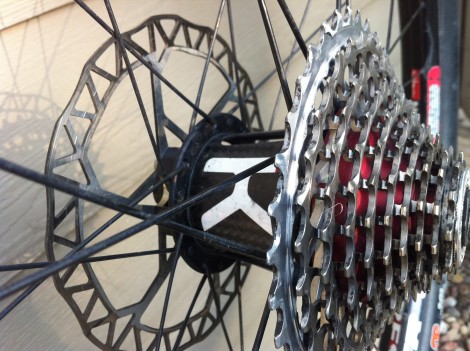Last month, we featured the first part of our tech features on the Kappius Components hub sets. The opportunity to ride these hubs in August was the result of heavy interest after first looking into the hubs and their features in March – check out our first look here. If you read both those articles, you may have a rough idea of what is going on inside the rear hub.
Although the design of the hub differs from a regular hub for a few reasons, it is the externally mounted oversize drive system that really sets the Kappius Hub apart. The carbon fibre and aluminium hub body is also oversized, so the 6 bolt disc mounting is also part of the flange on the non-drive side. On the drive side lies the drive system. The drive system is based on an 8 pawl drive, where the pawls are magnetically sprung. They engage in pairs to a 60 tooth drive ring. This creates a 1.5 degree engagement – which is about twice as fast as anything else on the market.
This does not work in isolation – an oversized drive system needs a specific cassette. Russell Kappius has converted SRAM XX Cassettes to suit this task. There is a whole lot of room behind a cassette that can be used, and that is exactly what has been achieved with the Kappius Hub. The cassette is held on via a slip fit, and held in place by the axle end cap, which is fitted by hand. The cassette can also be interchanged with a singlespeed cog, which is what Clifbar Pro Brady Kappius used at the 2012 Breck Epic.
Brady Kappius uses the singlespeed mount on his Kappius Hub. It’s a tool free swap from running a 10speed cassette.
Having the fitting and removal is a huge bonus. Currently, Kappius tools the cassette conversions himself, and sells the modified cassettes at a normal retail price. The use of end caps opens up easy changes of bikes for the wheels too. A simple tool free change of end caps can swap from 135mm QR, to 135 10mm thru axle, or to 142×12. This simplicity of design is something Kappius aimed for when designing the hubs. Durability was his other key goal. By moving the bearings outboard, and increasing their size, this should be achieved. A large amount of testing, and a lot of real world use has lead to show the durability of the product.
Watching the video below is the best way to gain an idea of what is going on inside:
Christophe Sauser is well known to source the best equipment for his bikes. For sometime after signing with Specialized, he still ran his Cannondale SI cranks – as their low weight and stiffness was unparalleled. Sauser found out about the hubs that Russell Kappius had designed and produced, and bought some for himself. He raced to 2nd place at the 2012 Leadville 100 on them, and has since ordered another set.
So that is what is inside, and what makes it work as it does? For our third and final part of this Tech feature, we will let you know how they rode – and why a set is on order to come our way in January.

